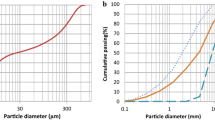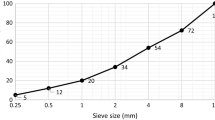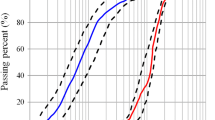Abstract
In this paper, the effect of silica fume (SF) on the chloride diffusion coefficient of concrete subjected to repeated loading was examined. Portland cement was replaced by 5 and 10 % SF. Five cycles repeated loadings were applied to concrete specimens, the maximum loadings were 40 and 80 % of the axial cylinder compressive strength (\( f_{\text{c}}^{\prime } \)), respectively. The diffusion coefficients were calculated from the steady state in the chloride migration test using the Nernst-Planck equation. The service life of concrete in chloride environment was predicted by Life-365 model. The results indicate that the diffusion coefficients of concrete containing 5 and 10 % SF replacements are lower than that of the control concrete at the age of 28 days. This trend increases with the increase of SF replacement. Five cycles repeated loading at 40 % \( f_{\text{c}}^{\prime } \) or 80 % \( f_{\text{c}}^{\prime } \) increase the diffusion coefficients (D 28) for all mixes investigated in this study. However, the effect of 80 % \( f_{\text{c}}^{\prime } \) on D 28 of concrete with 10 % SF is significantly lower than that of the control concrete without SF. Compared with the control concrete without SF, 10 % SF replacements increase the service life of concrete by more than 10 times.








Similar content being viewed by others
References
Buenfeld NR, Glass GK, Hassanein AM et al (1998) Chloride transport in concrete subjected to electric field. J Mater Civ Eng 10(4):220–228
Glass GK, Buenfeld NR (2001) Chloride-induced corrosion of steel in concrete. Prog Struct Eng Mater 2(4):448–458
Jaffer SJ, Hansson CM (2009) Chloride-induced corrosion products of steel in cracked-concrete subjected to different loading conditions. Cem Concr Res 39(2):116–125
Poupard O, Aït-Mokhtar A, Dumargue P (2004) Corrosion by chlorides in reinforced concrete: determination of chloride concentration threshold by impedance spectroscopy. Cem Concr Res 34(6):991–1000
Chung DDL (2002) Review: improving cement-based materials by using silica fume. J Mater Sci 37(4):673–682
Cohen MD, Bentur A (1988) Durability of Portland cement silica fume pastes in magnesium sulfate attack and sodium sulfate solution. ACI Mater J 85(3):148–157
Dotto JMR, de Abreu AG, Dal Molin DCC et al (2004) Influence of silica fume addition on concretes physical properties and on corrosion behaviour of reinforcement bars. Cem Concr Compos 26(1):31–39
Shekarchi M, Rafiee A, Layssi H (2009) Long-term chloride diffusion in silica fume concrete in harsh marine climates. Cem Concr Compos 31(10):769–775
Luther MD (1988) Silica fume (microsilica) concrete in bridges in the United States. Transp Res Rec 1204:11–20
Zain MFM, Safiuddin M, Mahmud H (2000) Development of high performance concrete using silica fume at relatively high water-binder ratios. Cem Concr Res 30(9):1501–1505
Kjellsen KO, Hallgren M, Wallevik OH (2000) Fracture mechanical properties of high-performance concrete—influence of silica fume. Mater Struct 33(9):552–558
Hooton RD (1993) Influence of silica fume replacement of cement on physical properties and resistance to sulfate attack, freezing and thawing, and alkali-silica reactivity. ACI Mater J 90(2):143–151
Kayali O, Zhu B (2005) Corrosion performance of medium-strength and silica fume high-strength reinforced concrete in a chloride solution. Cem Concr Compos 27(1):117–124
Gesoğlu M, Güneyisi E (2007) Strength development and chloride penetration in rubberized concretes with and without silica fume. Mater Struct 40(9):953–964
Živica V (2000) Sulfate resistance of the cement materials based on the modified silica fume. Constr Build Mater 14(1):17–23
Smith BG (2001) Durability of silica fume concrete exposed to chloride in hot climates. J Mater Civ Eng 13(1):41–48
Toutanji H, McNeil S, Bayasi Z (1998) Chloride permeability and impact resistance of polypropylene-fiber-reinforced silica fume concrete. Cem Concr Res 28(7):961–968
Bentz DP (2000) Influence of silica fume on diffusivity in cement-based materials: II. Multi-scale modeling of concrete diffusivity. Cem Concr Res 30(7):1121–1129
Saito M, Ishimori H (1995) Chloride permeability of concrete under static and repeated compressive loading. Cem Concr Res 25(4):803–808
Samaha HR, Hover KC (1992) Influence of microcracking on the mass transport properties of concrete. ACI Mater J 89(4):416–424
Cao QW, Wan XM, Zhao TJ et al (2008) Effect of mechanical loading on chloride penetration into concrete. Zhejiang University Press, Hangzhou
Parant E, Pierre R, Maou FL (2007) Durability of a multiscale fibre reinforced cement composite in aggressive environment under service load. Cem Concr Res 37(7):1106–1114
Sun W, Mu R, Luo X et al (2002) Effect of chloride salt, freeze-thaw cycling and externally applied load on the performance of the concrete. Cem Concr Res 32(12):1859–1864
Yoon S, Wang K, Weiss WJ et al (2000) Interaction between loading, corrosion, and serviceability of reinforced concrete. ACI Mater J 97(6):637–644
Friedmann H, Amiri O, Aït-Mokhtar A et al (2004) A direct method for determining chloride diffusion coefficient by using migration test. Cem Concr Res 34(11):1967–1973
Kermani A (1991) Permeability of stressed concrete. Build Res Inf 19(6):360–366
Choinska MKA, Chatzigeorgiou G, Pijaudier-Cabot G (2007) Effects and interactions of temperature and stress-level related damage on permeability of concrete. Cem Concr Res 37(1):79–88
Hearn N (1996) Effect of shrinkage and load-induced cracking on water permeability of concrete. ACI Mater J 96(2):234–241
Sugiyama T, Bremner TW, Holm TA (1996) Effect of stress on gas permeability in concrete. ACI Mater J 93(5):443–450
Kosmatka SH, Kerkhoff B, Panarese WC (2003) Design and control of concrete mixtures, 14th edn. Portland Cement Association, Skokie, pp 180–185
Japan Society of Civil Engineers standard. (2003) Test method for effective diffusion coefficient of chloride ion in concrete by migration. JSCE-G571
Hisada M, Nagataki S, Otsuki N (1999) Evaluation of mineral admixtures on the viewpoint of chloride ion migration through mortar. Cem Concr Compos 21(5–6):443–448
Prince W, Gagn R (2001) The effects of types of solutions used in accelerated chloride migration tests for concrete. Cem Concr Res 31(5):775–780
McGrath PF, Hooton RD (1996) Influence of voltage on chloride diffusion coefficients from chloride migration tests. Cem Concr Res 26(8):1239–1244
Feldman RF, Huang CY (1985) Properties of Portland cement-silica fume pastes II. Mechanical properties. Cem Concr Res 15(6):943–952
Rao GA (2001) Development of strength with age of mortars containing silica fume. Cem Concr Res 31(8):1141–1146
Hamad B, Machaka M (1999) Effect of transverse reinforcement on bond strength of reinforcing bars in silica fume concrete. Mater Struct 32(6):468–476
Detwiler RJ, Mehta K (1989) Chemical and physical effects of silica fume on the mechanical behavior of concrete. ACI Mater J 86(6):609–614
Bentz DP, Stutzman PE (1994) Evolution of porosity and calcium hydroxide in laboratory concretes containing silica fume. Cem Concr Res 24(6):1044–1050
Mazloom M, Ramezanianpour AA, Brooks JJ (2004) Effect of silica fume on mechanical properties of high-strength concrete. Cem Concr Compos 26(4):347–357
Song HW, Jang JC, Saraswathy V, Byun KJ (2007) An estimation of the diffusivity of silica fume concrete. Build Environ 42(3):1358–1367
Bentz DP, Jensen OM, Coats AM et al (2000) Influence of silica fume on diffusivity in cement-based materials: I Experimental and computer modeling studies on cement pastes. Cem Concr Res 30(6):953–962
Andrade C (1993) Calculation of chloride diffusion coefficients in concrete from ionic migration measurements. Cem Concr Res 23(3):724–742
Detwiler RJ, Kjellsen KO, Gjorv OE (1991) Resistance to chloride intrusion of concrete cured at different temperatures. ACI Mater J 88(1):19–24
Dhir RK, Jones MR, Ahmed HEH et al (1990) Rapid estimation of chloride diffusion coefficient in concrete. Mag Concr Res 42(152):177–185
Zhang TW, Gjørv OE (1994) An electrochemical method for accelerated testing of chloride diffusivity in concrete. Cem Concr Res 24(8):1534–1548
Song HW, Pack SW, Nam SH et al (2010) Estimation of the permeability of silica fume cement concrete. Constr Build Mater 24(3):315–321
Ahmad S (2003) Reinforcement corrosion in concrete structures, its monitoring and service life prediction-a review. Cem Concr Compos 25(4–5):459–471
Clifton JR (1993) Predicting the service life of concrete. ACI Mater J 90(6):611–617
Liang MT, Wang KL, Liang CH (1999) Service life prediction of reinforced concrete structures. Cem Concr Res 29(9):1411–1418
Song HW, Shim HB, Petcherdchoo A et al (2009) Service life prediction of repaired concrete structures under chloride environment using finite difference method. Cem Concr Compos 31(2):120–127
Zhang JY, Lounis Z (2009) Nonlinear relationships between parameters of simplified diffusion-based model for service life design of concrete structures exposed to chlorides. Cem Concr Compos 31(8):591–600
Violetta B (2002) Life-365 service life prediction model. Concr Int 24(12):53–57
Boddy A, Bentz E, Thomas MDA et al (1999) An overview and sensitivity study of a multimechanistic chloride transport model. Cem Concr Res 29(6):827–837
Life-365 V2.0.1 users manual, 2010
Ehlen MA, Thomas MDA, Bentz EC (2009) Life-365 Service Life Prediction Model(TM) version 2.0. Concr Int 31(5):41–46
Manget PS, Molloy BT (1994) Prediction of long-term chloride concentration in concrete. Mater Struct 27(170):338–346
Ba HJ, Zhang WM (2007) Accelerated life test and service life prediction of concrete. J Chin Ceram Soc 35(2):242–246 (in Chinese)
Acknowledgments
This work was supported by the national natural science foundation of China (Grant no. 50808045), the natural science foundation of Beijing (Grant no. 2112024) and an open foundation of state key laboratory of coastal and offshore engineering, Dalian University of Technology (Grant no. LP1013).
Author information
Authors and Affiliations
Corresponding author
Rights and permissions
About this article
Cite this article
Zhang, Wm., Ba, Hj. Effect of silica fume addition and repeated loading on chloride diffusion coefficient of concrete. Mater Struct 46, 1183–1191 (2013). https://doi.org/10.1617/s11527-012-9963-6
Received:
Accepted:
Published:
Issue Date:
DOI: https://doi.org/10.1617/s11527-012-9963-6




